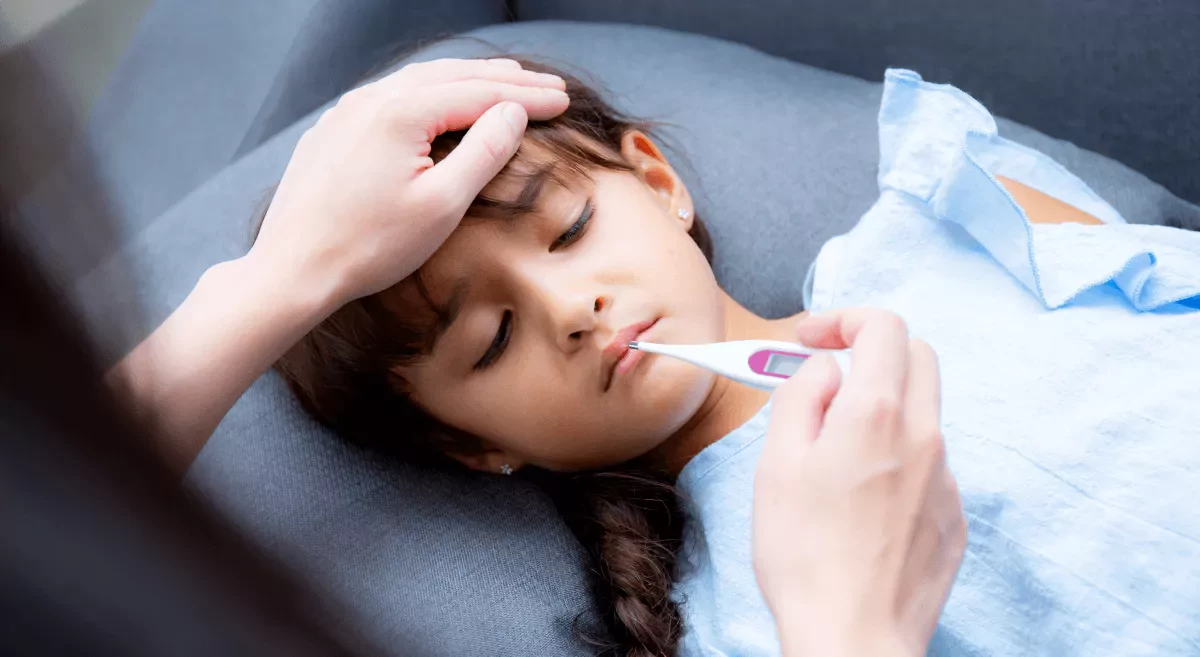What is a Fever?
Normal body temperature is 98.6 degrees Fahrenheit, or 37 degrees Celsius.
Fever or high body temperature is a common childhood symptom and occurs as part of the body’s normal response to many illnesses, especially infections. It is usually defined as a temperature of 38 degrees Celsius or 100.4 degrees Fahrenheit and higher when checked in the rectum. It must be remembered that the body temperature varies a little throughout the day, it differs by age and by activity level.
Why Does Fever Occur?
Fever is a normal body response and is a symptom which suggests an underlying illness. During illnesses, the body’s temperature is raised to help fight off these illnesses. Various chemicals such as cytokines and other mediators which are released in response to microbial invasions are involved in causing fever.
What are the Common Causes for Fever?
The most common causes of fever in children are viral infections. Bacterial infections can lead to ear infections, pneumonia and urinary tract infections and are another important cause of fever in children. Fevers can also occur without infections in allergies, following vaccination, Dehydration, Heat stroke etc.
How to Check for Fever?
A fever must always be documented by checking with a thermometer as ‘warm’ or ‘high’ body temperature is very subjective, and it’s better not to depend on touch to determine if a child has a fever or not. A digital thermometer is recommended to check for fever in children, these use heat sensors to record body temperature. They can be used in the rectum (rectal), mouth (oral) or armpit (axillary). The armpit is the most common site for checking fevers, though the axillary temperature is 0.5–1.0°F lower than the oral temperature while the rectal temperature is 0.5–1.0°F higher than the oral temperature.
When checking the armpit temperature, place the thermometer under the child's armpit making sure it touches the skin and not the clothes. When checking the temperature in the oral cavity, place the tip of the thermometer under the child's tongue toward the back of the mouth and ask the child to keep his or her lips closed. Once the thermometer (armpit or oral) signals that it's done (often with a beep) read the number. Wait for 15 minutes to check the oral temperature if the child has had something to eat or drink.
| Age | Best place to check temperature | When is it Fever |
|---|---|---|
Birth to 6 months |
|
|
6 months to 5 years |
|
|
>5 years |
|
|
When should you Treat Fever?
Fevers are normal phenomena during illness, often the child feels hot and appears flushed. Fevers can also cause headaches, sweating or shivering. Not all fevers need treatment as they are part of the natural immune response. However, if the child is feeling discomfort, or is associated with other symptoms such as headaches, body aches, fever can be treated.
Always - Make sure the right dose of paracetamol is being used and consult your paediatrician for knowing what the right dose is for your child. It is based on the age and weight of the child.
When to Seek Medical Attention?
In certain cases, it is important for the child to be urgently seen by a doctor when he/she is having a fever. This may be when
- An infant under 3 months has a temperature of 38°C (101°F) or above.
- Infants over 3 months have temperatures of 39°C (102°F) or above.
- A child with a fever has persistent vomiting or is refusing to feed.
- The child is showing extreme lethargy, and drowsiness; a weak, high-pitched or continuous cry or irritability.
- There are signs of hurried breathing, noisy breathing, and wheezing.
- The child has signs of dehydration in the form of Poor feeding, Dry mucous membranes, Reduced urine output, and cool skin.
- When a child with fever has fits (These fits usually occur between 6 months to 5 years old).
- Do not over clothing the child, keep them in a cool airy environment.
- Maintain hydration during fever
- For comfort, Tepid sponging with lukewarm water at 28–30°C (Continuously sponge the child all over the body for about 15 min).
Supportive Care
- Do not over-clothing the child, keep them in a cool airy environment
- Maintain hydration during fever
- For comfort, Tepid sponging with lukewarm water at 28–30°C (Continuously sponge the child all over the body for about 15 min).
Do Not
- Withhold medications for fever even if tepid sponging is being done, use of sponging alone is not recommended
- Use cold water for sponging
- Keep young infants esp < 3 months, exposed for long for sponging, as they may be at risk for hypothermia (low body temperature)
- Self-medicate with antibiotics.





